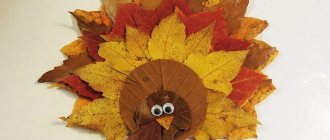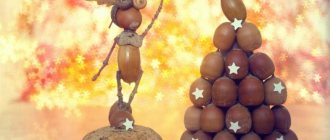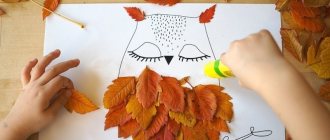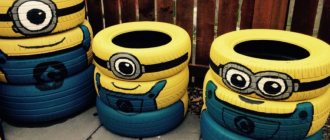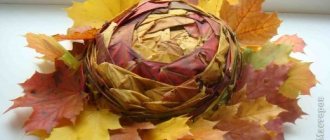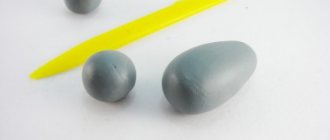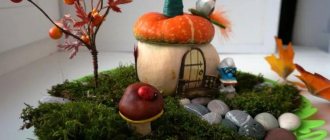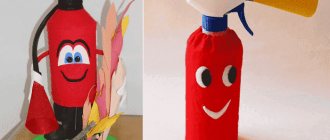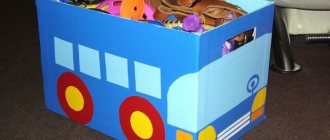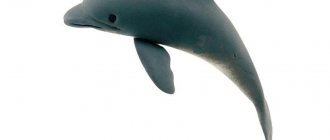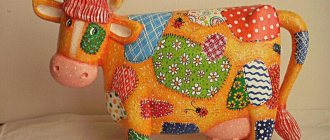crafts for kindergarten on February 23
iKids on Defender of the Fatherland Day are happy to congratulate the most authoritative people for them - dads and grandfathers. Older brothers or uncles also become suitable candidates for congratulations and gift giving. -yourself crafts for February 23rd in kindergarten Whether it’s a tank made of plasticine or an applique for February 23 , with them a child gives the whole world to a loved one. Usually on Defender of the Fatherland Day, craft competitions are held for kindergarten , including senior and junior groups. Help your preschooler make a February 23rd gift for dad with one of the simple February 23rd kindergarten craft ideas presented in this article. Here you will find many examples of holiday crafts for kindergarten with master classes and simple instructions, ranging from cute cards and appliqués to formidable military equipment made from plasticine and scrap materials. Don’t forget that for young children in the junior group of kindergarten, the craft for February 23 can even be a hand-drawn postcard with the first scribbles, but made with love. Therefore, do not attach too much importance to the appearance of the craft and its variety. A gift doesn't have to be complicated to be special!
Types of creativity for children
Modeling
Any child will like it. A lot of materials appear in front of children and using each they will be able to assemble a little man or a car. Plasticine, clay, and special sand force the child to come up with new crafts and collect them.
Drawing
This type is beautiful because you can draw anywhere. Draw houses on sheets of paper, draw on crafts, cardboard, chalkboard and even on the pavement. There are a lot of materials for drawing. Starting from coal and ending with a paint roller.
Weaving
Not suitable for many, especially boys. We do not recommend weaving products using small beads; large beads are better suited. This look is perfect for conveying the feelings of a child to his mother. He will try and create beautiful crafts for his mother. Often, children in kindergarten understand that wearing baubles is cool, so teach your child how to weave them.
Applications
This view is excellent for the development of children. Cards, frames and even various figures are created from paper. One of the first gifts for relatives from a child will be postcards.
Modeling
The most expensive type of activity for a child. In stores you can buy kits for creating an airplane, a train and various cars. The child may enjoy assembling everything according to the instructions and turning the screws.
Modeling
Many people are accustomed to associating modeling only with plasticine. Indeed, you get unique plasticine crafts for children. However, in the modern world, innovative means for this type of activity have appeared.
You get various models of cars, planes, animals and other objects. Try using clay and sand with your child.
Cardboard+clothespins
Using clothespins is a great way to develop fine motor skills. The child quickly gets tired of simply pressing the ends of the clothespin, but if this process becomes part of creating a craft, it will captivate the child for a long time. Cut out a base from colored cardboard or a plastic plate and paint it.
Draw eyes and a smile on the circle. Next, ask your child to attach clothespins to the base. If you do this in a circle, you will get a sun, if only on the sides there is a crab, only on the bottom there is an octopus.
Paper applications
Paper is an affordable and useful material for children's crafts. It can be crushed into balls, torn into small pieces, folded, glued - all this is very useful for little hands.
Paper crafts for 2-year-old children most often take the form of appliqués. The plots should be chosen as simple as possible. It could be a house of two or three fragments, a mushroom, a snowman, a butterfly, a sun, a flower, a tree and much more. The parts need to be cut out in advance; it is too early for the baby to pick up scissors.
You can combine the application method with learning new material:
- stick geometric shapes;
- study the seasons by adding leaves to trees (for example, autumn leaves);
- learn to count using glued parts as an example;
- invent fairy tales and stories, develop the baby’s speech.
Lots of ideas! The main thing to remember is that learning should take place in a playful way so that the child finds it interesting. Therefore, after the creative process, you should switch your attention to something else and return to the craft a little later.
Coloring with cocktail straws
At 1-1.5 years old, a child cannot fully hold a pencil or pen in his hands, but he can easily take a cocktail straw in his fist.
To get him interested in coloring, invite him to dip a tube in paint and place colorful circles inside the outline. You need to continue until the outline of the drawing is completely filled.
Finger drawing
Small children experience the world literally by touch.
That is why they love to get into everything with their hands. This feature can also be used. Allow your child to decorate their hands with paints. You can make a whole drawing out of prints. The palms make excellent peacocks, clowns with finger hair, octopuses and everything that your imagination suggests. Fingerprints perfectly imitate leaves, snow flakes, and raindrops.
It is worth noting that only safe “finger” paints are suitable for drawing with your hands, which will not harm the baby’s delicate skin.
Handprints can be cut out and used to create appliques. From the palms you can collect a peacock's tail, the rays of the sun, and the spines of a hedgehog.
Adviсe
- Having chosen the type of activity, do not buy a lot of materials for creativity, perhaps the child will not like doing this activity and all the things you bought will lie idle. It’s better to buy a little of everything to find out the child’s wishes and opinion about crafts. And then the idea of what to do will come.
- Start with simple ones and gradually move on to more complex crafts. You need to learn new things gradually and with enthusiasm.
- Be patient and prepared for your child’s failures; the craft will not work out the first time, but thanks to the help of family, children acquire new hobbies.
- At the beginning, take on all the main parts and leave only the most interesting things for the child.
- Pay special attention to the time when you are just starting out, you should not sit for many hours and try to assemble a craft from pine cones, it is better to spend ten minutes gluing glitter to the pine cone, and after that a couple more minutes creating the legs of the cone. This way, the child will not get bored and will have the opportunity to think about further actions with the craft.
- Crafts must be appropriate for the child’s age, otherwise failures can cause disappointment in one’s abilities and interest will quickly fade.
Crafts are a great way to spend time for a child; all family members do the same thing and help the child in his endeavors. Maybe even with the help of crafts, the child will want to become a designer or choose another creative profession, and all because you did this exciting activity with your child.
We strongly recommend leaving crafts until the child grows up; many become interested in what they did before and how they did it; if this is not possible, just take photos of early crafts. When you notice that your child has created something better than before, show him the old craft and emphasize that he is doing better and better. This will bring joy and help the child develop further. This method is recommended by experienced educators and teachers, and there are a lot of variations for its implementation.
Modeling
Implementation of models is not cheap. At specialized outlets, kits for building cars, military equipment and aircraft are purchased.
Boys will especially enjoy attaching screws and assembling objects. You must follow the instructions.
Plastic bottles
Once you are carried away by this type of creativity, you can not only surprise your friends with your wild imagination, but also, in the meantime, decorate a summer cottage for the delight of your beloved grandmother! So, a squad of cheerful gnomes can line up along the garden path, and one plastic bottle of any size is enough to make each of them.
It is enough to cut off the bottom and paint with paints, drawing a suit, hat, hair, beard, eyes, nose and mouth. Of course, creating complex models requires the participation of adults, since it involves the use of sharp knives, such as stationery knives.
But most of the work - cutting, coloring, assembling - the child can do on his own.
Before you begin this work, you should carefully consider the procedure, prepare all the necessary materials and follow the step-by-step instructions for making crafts for children, invented independently or taken from other sources.
Plastic construction, in a sense, is akin to Lego: it combines three-dimensional parts made from source materials of suitable shape (bottles of different sizes and shapes).
So you can make the heroes of your favorite cartoons - Winnie the Pooh, Minions, Stitch or Pony, characters from folk tales - the Old Man, the Old Woman, the Fox, the Wolf and the Hare, and make themed compositions. And during the summer holidays, the dacha will turn into a Magic Land!
Herbarium
The craft will open the world of plants for the child. During autumn, leaves fall from the trees. It is collected for drying in books and newspapers, and is also used in creativity. When collecting leaves, parents should pay attention to introducing the baby to various trees.
The child must understand what surrounds him and develop his horizons.
Disk figures
Everyone has old disks in their home that have become damaged or are no longer in demand. Put them to work to create a fun craft for kids. Children love Smeshariki.
Depict popular cartoon characters on the discs. You will need the disc itself, a marker and a little creativity. Based on the photo of crafts for children aged 6 years, there are many examples of animal embodiments.
Cheerful hedgehog
Prepare white cardboard (you can use another one), scissors, glue, black pencil.
Cut out everything needed to make the face and paws. Cut the brown paper into strips one centimeter wide along the width of the sheet.
Glue the strips as shown in the picture. Glue the muzzle and paws into the middle. Using a black felt-tip pen, draw out the elements of the muzzle.
Pasta
Thanks to the variety of sizes, shapes and even colors, this food product has long established itself as a material for creativity. And not only for children! Not every traditional material can boast such a variety of forms of use - from simple and complex paintings to decorative dishes.
It is better for younger children to master the technology of flat paintings, where pasta can act as sun rays, flowers or flower petals, elements of folk ornament. Later, you can get acquainted with semi-volumetric panels, and then move on to making three-dimensional models.
A rustic house assembled from pasta tubes, flower bouquets from pasta shells or spirals, cups, teapots, candlesticks or boxes are excellent DIY craft options for children 9 years old and older.
Pictures with plasticine instead of glue
This material can be used to glue pieces to a sheet of cardboard. We prepare in advance what we will glue (buttons, pasta, paper figures and much more).
We give the baby plasticine and teach him to tear off small pieces. Then each piece is pressed against the sheet with a finger, and the desired part is glued onto it.
Combination of several techniques
For the craft, you need to illustrate some animal on paper. It could be a hedgehog. To detail the animal's needles, use glue to add seeds to the body. They will serve as needles. Creating a home for the animal is done with toothpicks.
Make decorations for the house from the herbarium. Use glitter to depict the sun for the plot. You will use many techniques in one job, which will push your craft to the next level. It will be easier for your child to learn in labor classes and creative sections.
DIY crafts - interesting ideas
Herbarium
The easiest way to teach your child about plants is to collect a herbarium.
In autumn, trees shed their leaves, plants prepare for winter, and this is an excellent time to collect material. All you need is a book and a place to store dried plants. When collecting plants, you should explain to your child about the types, purposes and smells of the future herbarium; this will awaken the desire to look for more and more new flowers and leaves.
Lumps of paper
Take a napkin and demonstrate to your child how to roll the lumps. Everyone will obviously enjoy tearing paper, and learning about the possibility of making beautiful pictures will surprise a child. Use napkins of different colors, with patterns and different figures. When the child masters lumps, tell him that he can tear the paper to create squares, circles and other shapes. Use these blanks for a painting.
Combining all kinds of crafts
Take a sheet of paper and start drawing on it, for example, draw a beautiful hedgehog. The hedgehog should have needles, so glue the seeds. He should also have a house; assemble a small house from sticks (toothpicks). Decorate it with flowers from the herbarium, and you can draw the sun with sparkles. Thanks to this master class, the child will touch on many types of crafts and will not use the same method of creation.
Early combination will help the child navigate school during labor lessons.
Felt products
The affordable and colorful material is a favorite among crafters. Unlike other fabrics, it does not require fixing the edges and is easily attached with glue.
Children and adults can make a flower bed out of felt flowers, which they need to attach to sushi sticks or skewers.
Animal kittens
Materials: white and pink paper, scissors, glue, pencils, ribbon for a bow.
Make details according to the sample. Take a rectangle for the body and divide it into three parts so that the central one is 2 times larger than the outer ones.
On the central part, draw the legs and color of your kitten. Fasten the two side parts together at the bottom.
Also draw a pattern of the kitten's color onto the small rectangle. Attach the tail at the back. Glue together all the elements of the muzzle. Glue to the body. Attach a bow.
For more interest, make a second kitten with a different color coat.
The same principle can be used for other animals. You can create a whole zoo. The main thing is the level of passion of your child.
How to prepare for the process
So that the process does not drag on and the child’s interest does not disappear prematurely, it is worth considering several nuances:
- You should think in advance and decide where the lesson will take place. It is usually convenient to sit in the kitchen, where there are no carpets or upholstered furniture. The ideal option would be a children's high chair.
- All materials must be prepared in advance. These could be cut-out parts, backgrounds for crafts, tools, and so on.
- It is advisable to put a special apron or sleeves on your baby, especially if you use paints.
How to choose materials for crafts with a 2-year-old child
At the age of two, children are still quite small, so you need to choose materials for crafts wisely.
- choose the most natural materials
- elements of materials should not be too small
- all materials and tools must be safe!
Please note that special scissors for children's creativity, paints and plasticine with age marks, and colored paper of different densities are currently on sale.
